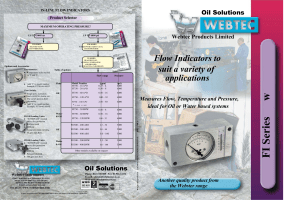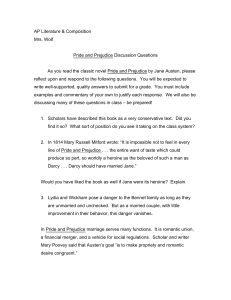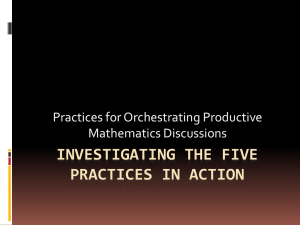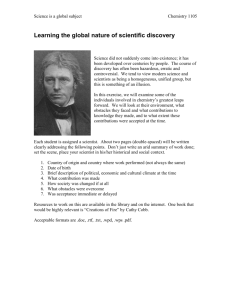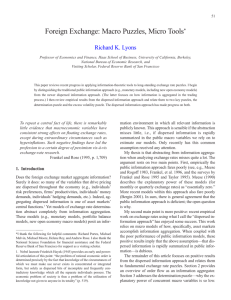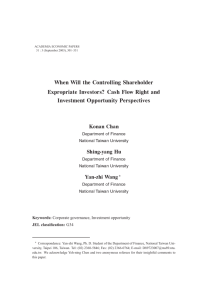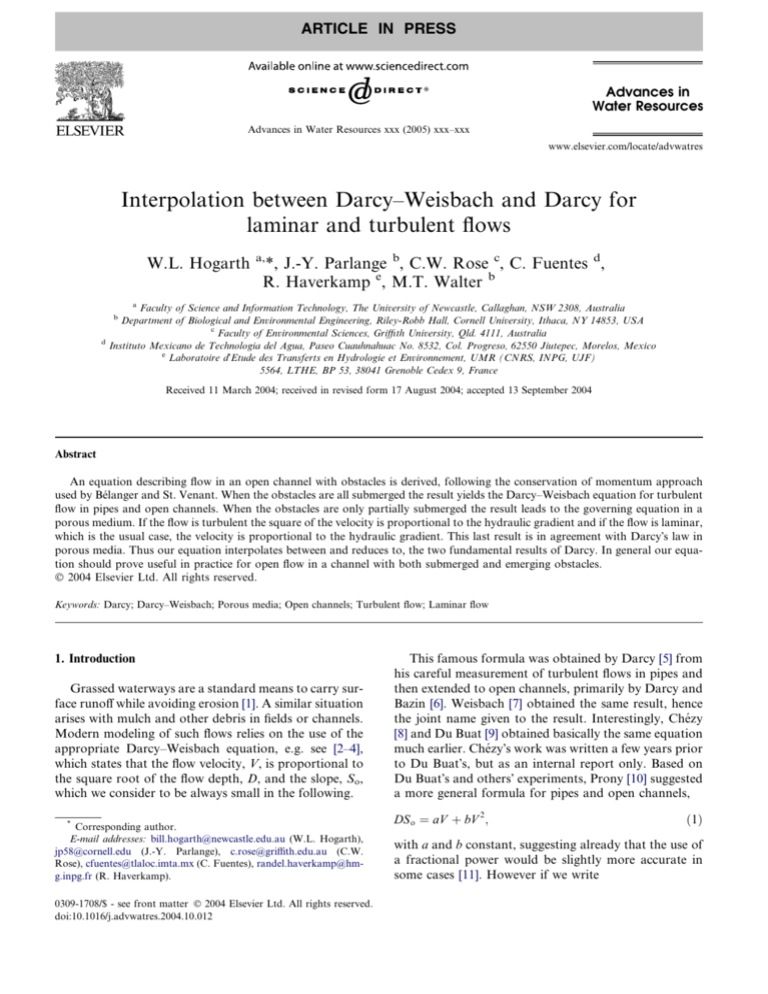
ARTICLE IN PRESS
Advances in Water Resources xxx (2005) xxx–xxx
www.elsevier.com/locate/advwatres
Interpolation between Darcy–Weisbach and Darcy for
laminar and turbulent flows
W.L. Hogarth a,*, J.-Y. Parlange b, C.W. Rose c, C. Fuentes d,
R. Haverkamp e, M.T. Walter b
a
Faculty of Science and Information Technology, The University of Newcastle, Callaghan, NSW 2308, Australia
Department of Biological and Environmental Engineering, Riley-Robb Hall, Cornell University, Ithaca, NY 14853, USA
c
Faculty of Environmental Sciences, Griffith University, Qld. 4111, Australia
Instituto Mexicano de Technologia del Agua, Paseo Cuauhnahuac No. 8532, Col. Progreso, 62550 Jiutepec, Morelos, Mexico
e
Laboratoire dÕEtude des Transferts en Hydrologie et Environnement, UMR (CNRS, INPG, UJF)
5564, LTHE, BP 53, 38041 Grenoble Cedex 9, France
b
d
Received 11 March 2004; received in revised form 17 August 2004; accepted 13 September 2004
Abstract
An equation describing flow in an open channel with obstacles is derived, following the conservation of momentum approach
used by Bélanger and St. Venant. When the obstacles are all submerged the result yields the Darcy–Weisbach equation for turbulent
flow in pipes and open channels. When the obstacles are only partially submerged the result leads to the governing equation in a
porous medium. If the flow is turbulent the square of the velocity is proportional to the hydraulic gradient and if the flow is laminar,
which is the usual case, the velocity is proportional to the hydraulic gradient. This last result is in agreement with DarcyÕs law in
porous media. Thus our equation interpolates between and reduces to, the two fundamental results of Darcy. In general our equation should prove useful in practice for open flow in a channel with both submerged and emerging obstacles.
Ó 2004 Elsevier Ltd. All rights reserved.
Keywords: Darcy; Darcy–Weisbach; Porous media; Open channels; Turbulent flow; Laminar flow
1. Introduction
Grassed waterways are a standard means to carry surface runoff while avoiding erosion [1]. A similar situation
arises with mulch and other debris in fields or channels.
Modern modeling of such flows relies on the use of the
appropriate Darcy–Weisbach equation, e.g. see [2–4],
which states that the flow velocity, V, is proportional to
the square root of the flow depth, D, and the slope, So,
which we consider to be always small in the following.
*
Corresponding author.
E-mail addresses: bill.hogarth@newcastle.edu.au (W.L. Hogarth),
jp58@cornell.edu (J.-Y. Parlange), c.rose@griffith.edu.au (C.W.
Rose), cfuentes@tlaloc.imta.mx (C. Fuentes), randel.haverkamp@hmg.inpg.fr (R. Haverkamp).
0309-1708/$ - see front matter Ó 2004 Elsevier Ltd. All rights reserved.
doi:10.1016/j.advwatres.2004.10.012
This famous formula was obtained by Darcy [5] from
his careful measurement of turbulent flows in pipes and
then extended to open channels, primarily by Darcy and
Bazin [6]. Weisbach [7] obtained the same result, hence
the joint name given to the result. Interestingly, Chézy
[8] and Du Buat [9] obtained basically the same equation
much earlier. ChézyÕs work was written a few years prior
to Du BuatÕs, but as an internal report only. Based on
Du BuatÕs and othersÕ experiments, Prony [10] suggested
a more general formula for pipes and open channels,
DS o ¼ aV þ bV 2 ;
ð1Þ
with a and b constant, suggesting already that the use of
a fractional power would be slightly more accurate in
some cases [11]. However if we write
ARTICLE IN PRESS
2
W.L. Hogarth et al. / Advances in Water Resources xxx (2004) xxx–xxx
D3 S o g
DV
¼f
;
m2
m
ð2Þ
where g is the acceleration of gravity and m the kinematic
viscosity, which is essentially the expression in [11], with
g added to be dimensionally correct, then we can consider a number of possibilities (see also [12] for a more
complete discussion). If f is linear we obtain the well
known Poiseuille law [13] for laminar flow, whereas if
f is quadratic the Darcy–Weisbach result follows. No
function, f, will yield DSo as a function of a fractional
power of V as possibly suggested by Eq. (1).
For pipes of relatively small sections taking a function, f, proportional to (DV/m)a, was shown by Reynolds
[14] to be best with a 1.75, i.e. less than a = 2 obtained
by Darcy–Weisbach, the latter being preferable for the
open channels which concerns us here. There is no value
of the a that would lead to ManningÕs well known equation [15], but it is interesting that if we take a = 1.8, i.e.
close to ReynoldÕs value of 1.753, and replace So in Eq.
(2) by S 0:9
o , then ManningÕs result follows. That 0.9
power being unjustified, theoretically at least, it is preferable to use either Darcy–Weisbach in open channel or
Reynolds in small tubes, for turbulent flow, and of
course Poiseuille for laminar flow.
Bélanger [16] considered the steady flow in an open
channel with slope So, which we take as small, and obtained the fundamental result, see [11] for a thorough
discussion of BélangerÕs contribution, which can be written as,
dD S o S e
¼
;
dx
1 F2
ð3Þ
q2
V2
;
¼
3
gD
gD
ð4Þ
where q = VD is the flux. Se is now called the friction
slope, such that when So = Se, dD/dx = 0 which, for instance for turbulent flow must reduce to Darcy–Weisbach. Thus with a = 2 i.e. f = (DV/m)2 in Eq. (2) then
we obtain
D3 S o g ¼
Cs 2 2
DV ;
2
ð5Þ
Cs/2 being the constant of proportionality in Eq. (2).
When dD/dx = 0, Se = So and hence
CsV 2
:
Se ¼
2gD
2. Interpolation formula and discussion
We essentially follow BélangerÕs approach [11,16]
taking into account the additional resistance caused by
submerged and partially submerged obstacles. With
the presence of obstacles the volume they occupy in
the flow can be significant [3] and we call h the porosity,
i.e. the volume of water/[volume of water + volume of
partially submerged obstacles]. If we call s the shear
stress experienced by the flow, it must be balanced by
the weight of water, the momentum and the pressure, or
s ¼ qgS o Dh þ qV 2 h
where F is the Froude number,
F2 ¼
is steady or not. Since we are interested in the laws of
resistance to flow we can consider steady state flows only
without loss of generality. Of course generalizing BélangerÕs results to unsteady flows was a fundamental contribution of St. Venant [17] and Eq. (3) can then be seen as
the steady state limit of the St. Venant equations, and as
a result is often referred to him, rather than Bélanger.
In the following we shall generalize Eq. (3) when both
submerged and/or partially submerged obstacles are
present in the channel. As the density of obstacles increases we shall obtain, in the limit, BoussinesqÕs equation [18] for groundwater flow when the Dupuit–
Forchheimer approximation holds [19], [20]. In this case
the Boussinesq equation is based on DarcyÕs other fundamental work on flow in porous media [21].
Much of the above historical background can be
found, with additional details, in [11,22] as well as other
historical reviews.
ð6Þ
Of course, at the time Bélanger used it Eq. (6) which
we call the Darcy–Weisbach equation, was based on Du
BuatÕs results.
In the following, like Bélanger, we shall consider steady flows only, as the laws of resistance to flow, e.g.
Darcy–Weisbach, play the same role whether the flow
dD
dD
qgDh
;
dx
dx
ð7Þ
where q is the density of the liquid and we replace the
stress by the friction slope, with the identity
s qgS e D;
ð8Þ
Se must take into account the soil surface and obstacles.
If there was no partially submerged obstacle, Eq. (6)
would hold with a modified Cs to take into account submerged obstacles. Indeed this is the standard approach
[2–4] used even when emerging obstacles were clearly
present. Here we write separately the effect of emerging
obstacles, or,
Se ¼
V2
½C s h þ C d Að1 hÞ;
2gD
ð9Þ
where A represents the ratio of the frontal area of the
emerging obstacle, and the cross section of the obstacle
A¼
4Dd
;
pd 2
ð10Þ
with d the characteristic diameter of the obstacle. The
coefficients h and (1 h) represent the proportion of
surfaces on which each stress is acting. For given obsta-
ARTICLE IN PRESS
W.L. Hogarth et al. / Advances in Water Resources xxx (2004) xxx–xxx
cles and a turbulent flow Cd and Cs should be constants
for given obstacles. Eqs. (7)–(9) complete the formulation of the problem, or
dD S o She
¼
;
dx 1 F 2
ð11Þ
which is, formally, almost identical to Eq. (3). If Cd is
neglected in Eq. (9) the result is consistent with the
Darcy–Weisbach equation [3–5]. If on the other hand
Cs is neglected compared to the effect of Cd we obtain
on equation very similar to that used in [23] and [24]
for emerging obstacles only (with minor discrepancies
for the effect of h, which were not important there as h
was very close to 1).
We can now show that if the emerging obstacles become more numerous and form a porous medium Eq.
(11) leads to DarcyÕs law for porous media [21]. In that
limit h will be significantly less than one and F2 will always be negligible in Eq. (11), which reduces to
Se
dD
;
¼ So dx
h
and from Eq. (9), ignoring the Cs term,
phd
dD
2
V ¼
g So ;
ð1 hÞ2C d
dx
ð12Þ
ð13Þ
where (So dD/dx) is the hydraulic gradient. For fully
turbulent flow our formulation gives V2 proportional
to the hydraulic gradient, which is the way DarcyÕs
law should be written [25]. Of course, in a porous medium the ReynoldsÕs number, Vd/m, is normally very small
and the flow is laminar and the drag Cd can then be written as
Cd ¼
C1m
Vd
ð14Þ
to be consistent with Eq. (2) for a Poiseuille flow, then
Eq. (13) becomes,
pd 2 h
dD
V ¼
g So ;
ð15Þ
2ð1 hÞmC 1
dx
which is in agreement with PoiseuilleÕs result. This of
course is the standard DarcyÕs equation for laminar
flows in porous media [21]. Interestingly this equation
also provides an estimate of the saturated conductivity
K¼
pd 2 hg
;
2ð1 hÞmC 1
ð16Þ
where C1 is a characteristic of the porous medium and
should be of order one.
3. Conclusion
Starting with the equation for an open channel turbulent flow, which is based on the Darcy–Weisbach equa-
3
tion, we added the resistance due to obstacles.
Submerged obstacles are still consistent with a Darcy–
Weisbach equation but with increased friction. This approach is standard and has been used in practice. With
emerging obstacles only we improved an earlier expression and the result is consistent with DarcyÕs law in porous media for laminar flow, which was the case
considered by Darcy. But our result also yields the
extension of DarcyÕs law for turbulent flows. Thus by
keeping the resistances of both submerged and emerging
obstacles we obtained a general equation which covers
the limiting results described by Darcy–Weisbach in
open channel and by DarcyÕs law in porous media.
Our equation should be useful in practice when both
submerged and emerging obstacles are present in open
channel, e.g. a grassed waterway.
References
[1] Ogrosky HG, Mockus V. Hydrology of agricultural land. In:
Chow VT, editor. Handbook of applied hydrology, vol.
21. McGraw-Hill; 1964. p. 1–97.
[2] Curran JH, Wohl EE. Large woody debris on flow resistance in
step-pool channels, Cascade Range, WI. Geomorphology
2003;51:141–57.
[3] Dunkerley D. Organic litter: dominance over stones as a source of
interrill flow roughness on low-gradient desert slopes at Fowlers
Gap, arid western NSW, Australia. Earth Surf Process Landforms
2003;28:15–29.
[4] Findeling A, Ruy S, Scopel E. Modeling the effects of a partial
residue mulch on runoff using a physically based approach. J
Hydrol 2003;275:49–66.
[5] Darcy HPG. Recherches expérimentales relatives au movement de
lÕeau dans les tuyaux. Paris: Imprimerie Nationale; 1857.
[6] Darcy H, Bazin H. Recherches hydrauliques; première partie,
recherches experimentales sur lÕécoulement de lÕeau dans les
canaux découverts. Paris: Imprimerie Nationale; 1865.
[7] Weisbach J. Lehrbuch der Ingenieur—und Maschinen—Mechanik. 2nd ed. Braunschweig; 1850.
[8] Chézy A. Rapport sur le canal de lÕYvette. As quoted in Herschel,
C. On the origin of the Chézy formula. J Assoc Eng Soc
1897;18:363–5.
[9] Du Buat PLG. Principes dÕhydraulique, verifiés par un grand
nombre dÕexpériences faites par ordre du gouvernement. second
ed. Paris; 1786.
[10] Prony Rde. Recherches physico-mathématiques sur la théorie des
eaux courantes. Paris; 1804.
[11] Darrigol O. Turbulence in 19th-century hydrodynamics. Histor
Stud Phys Biol Sci 2002;32:207–62.
[12] Fuentes C, de Leon B, Saucedo H, Parlange J-Y, Antonio ACD.
El sistema de ecuaciones de Saint-Venant y Richards del riego por
gravedad: 1. La ley potencial de resistencia hidráulica. Ingeniera
Hidraulica en México 2004;147(XIX):63–75.
[13] Poiseuille JL. Recherches expérimentales sur le movement des
liquides dans les tubes de trés petits diamètres. Comptes rendus de
lÕAcadémie des Sciences 1841;12:112–5. 1840:11:961–1048.
[14] Reynolds O. An experimental investigation of the circumstances
which determine whether the motion of water shall be direct or
sinuous and of the Law of Resistance in parallel channels. Philos
Trans Royal Soc London 1883;174.
[15] Manning R. On the flow of water in open channels and pipes.
Trans Inst Civil Engr Ireland 1891;20:161–207.
ARTICLE IN PRESS
4
W.L. Hogarth et al. / Advances in Water Resources xxx (2004) xxx–xxx
[16] Bélanger J-B. Essai sur la solution numérique de quelques
problèmes relatifs au movement permanent des eaux courantes.
Paris; 1828.
[17] Barré de Saint Venant AJC. Théorie du movement nonpermanent
des eaux avec application aux crues des rivières, et à lÕintroduction
des marées dans leurs lits. Comptes rendus des Séances de
lÕAcadémie des Sciences 1871;73:147–54. and 237–240.
[18] Boussinesq J. Essai sur la théorie des eaux courantes. Mémoires
présentés par divers savants à lÕAcadémie des Sciences
1877;23:1–680.
[19] Dupuit AJ. Traité théorique et pratique de la conduite et de la
distribution des eaux. Paris; 1865.
[20] Forchheimer P. Hydraulik, third ed. Leipzig and Berlin; 1930.
[21] Darcy H. Les Fontaines Publiques de la Ville de Dijon. Dalmont,
Paris; 1856.
[22] Rouse H, Ince S. History of hydraulics. New York: Dover Pub.
Inc; 1963.
[23] Rose CW, Hogarth WL, Ghadiri H, Parlange J-Y, Okom A.
Overland flow to and through a segment of uniform resistance. J
Hydrol 2002;255:134–50.
[24] Hogarth WL, Parlange J-Y, Rose CW. Addendum to overland
flow to and through a segment of uniform resistance. J Hydrol
2003;283:218–24.
[25] Irmay S. On the theoretical derivation of Darcy and Forchheimer formulas. Trans Am Geophys Union 1958;39:702–
7.



